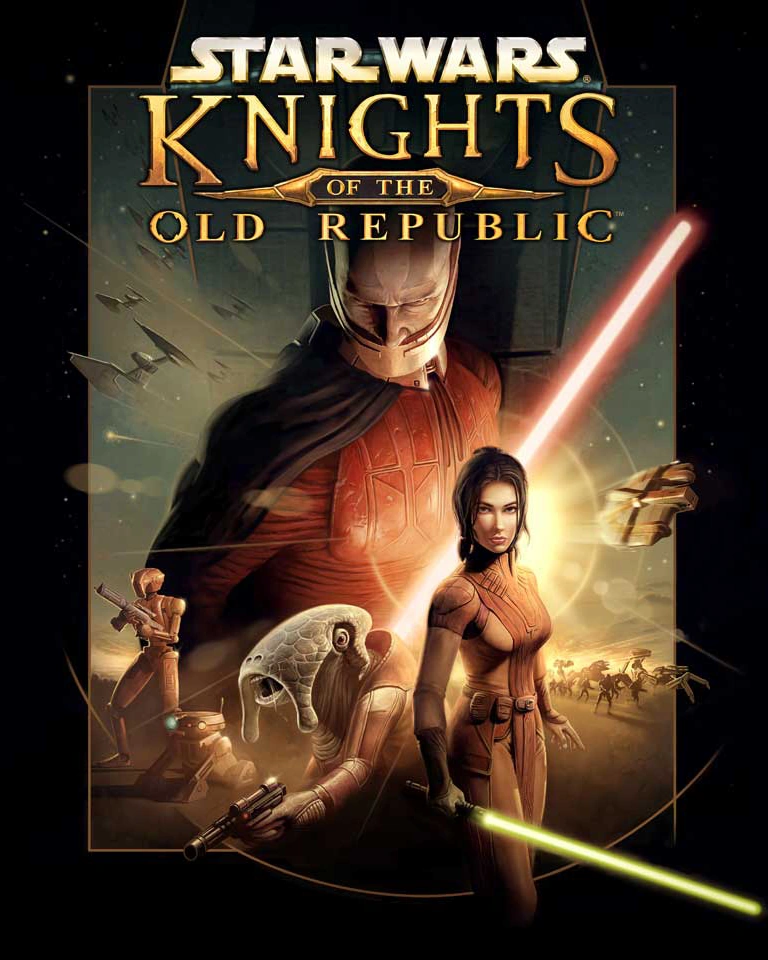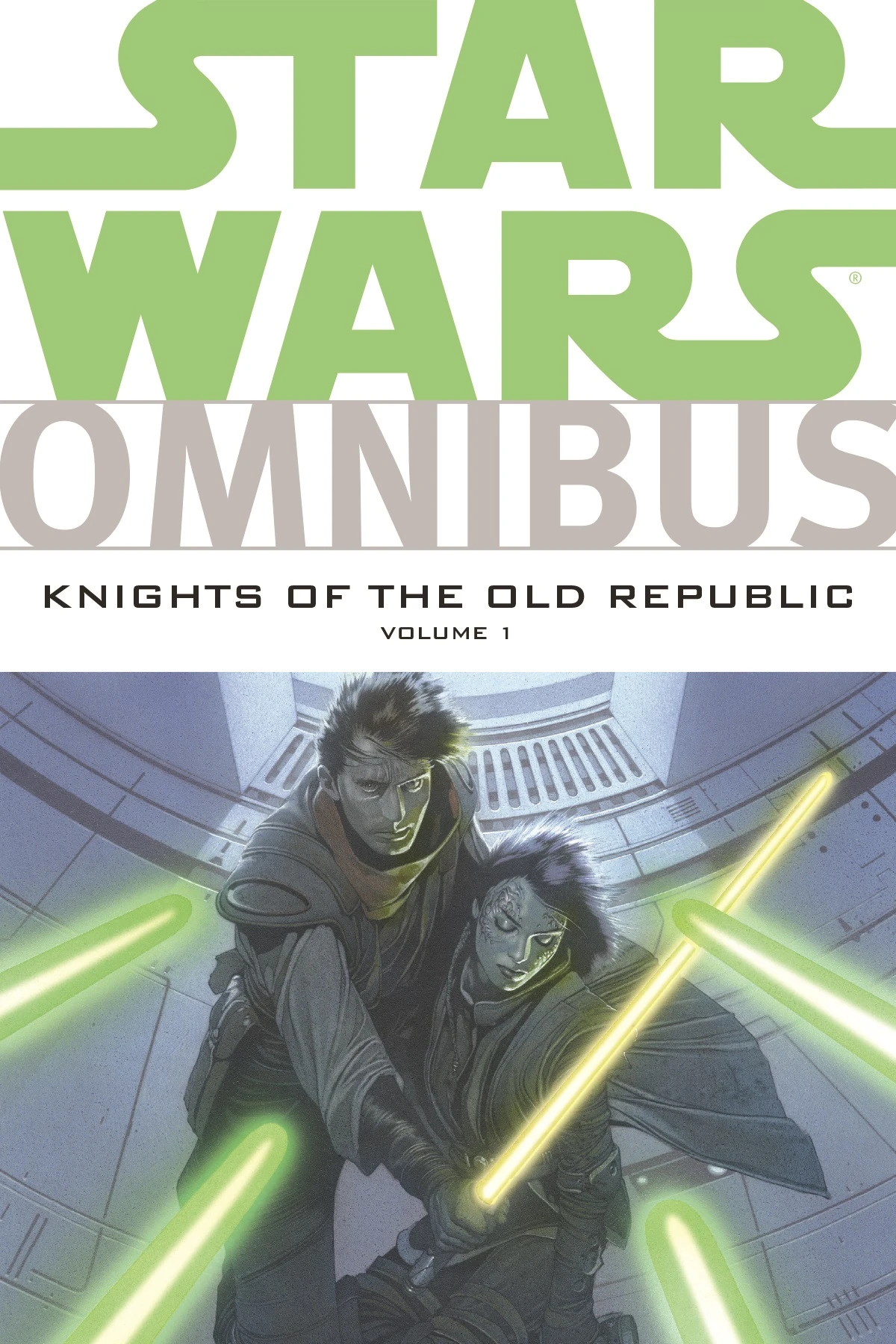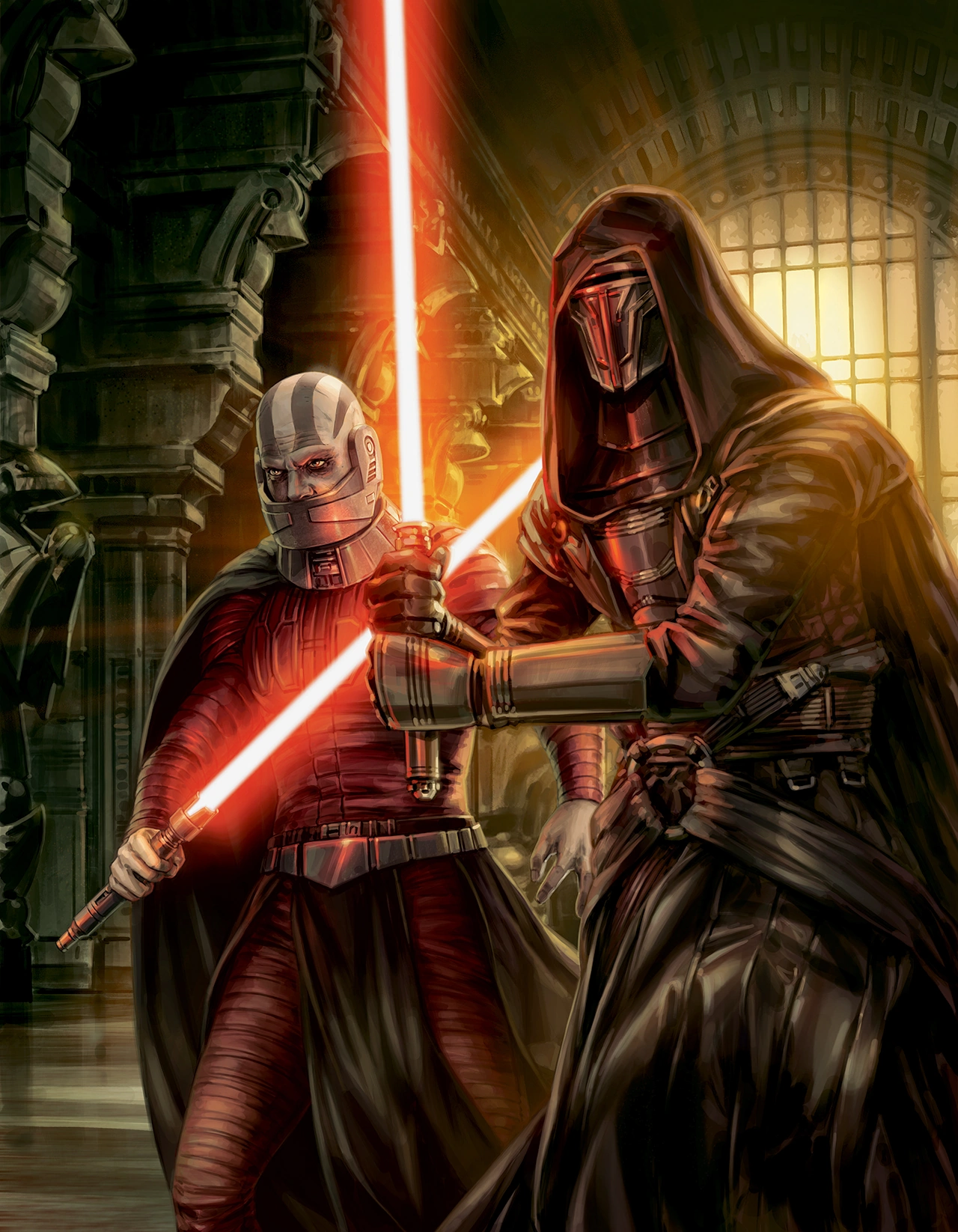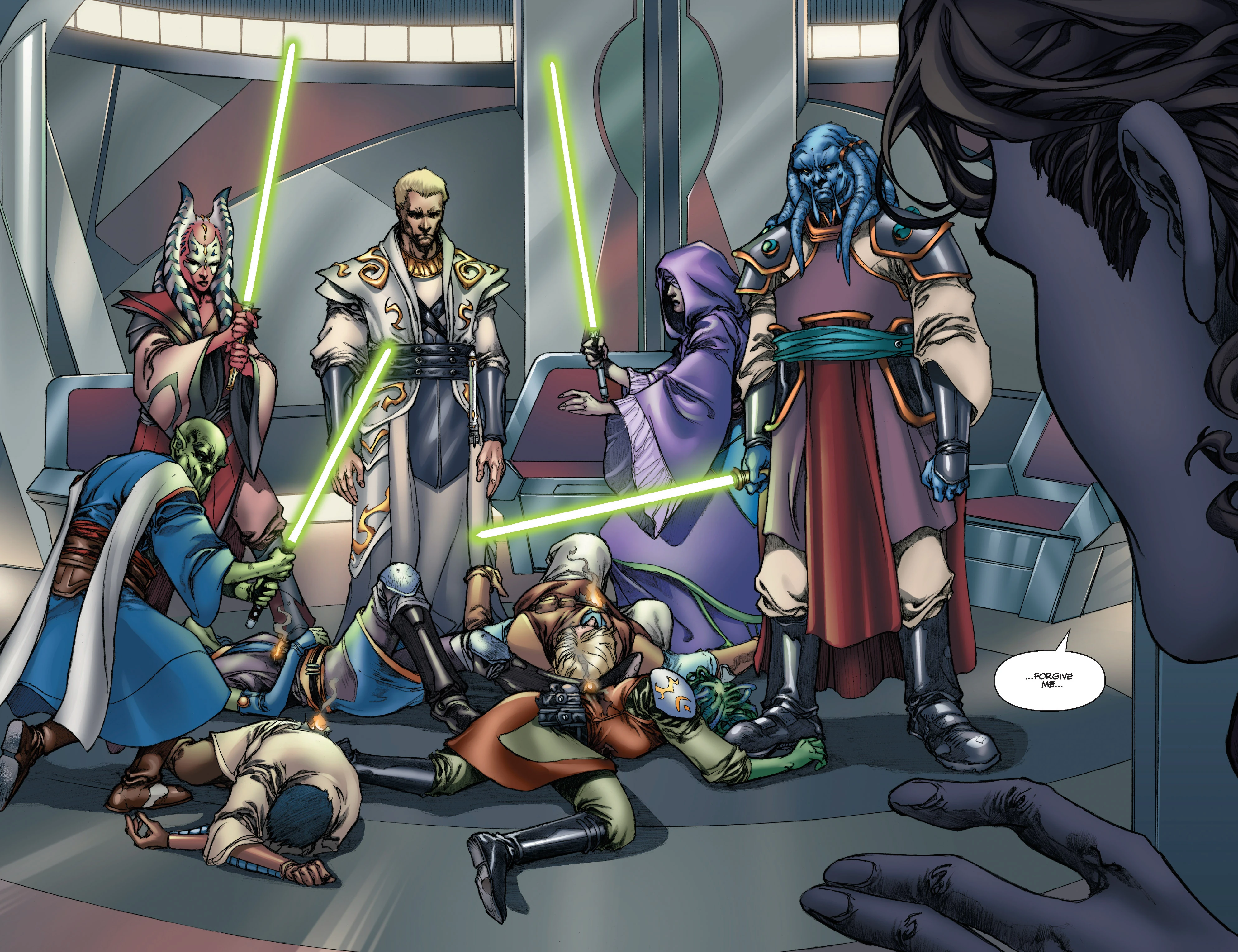The next items on my chronological read-through of Star Wars Legends stories are those associated with Knights of the Old Republic.
This is the first time I won't be merely discussing novels or comics, but other media such as video games.
For this review, I consumed the following material:
 |
| Star Wars: Knights of the Old Republic. Image from Wookieepedia. |
- Star Wars: Knights of the Old Republic 0-50 (comic by John Jackson Miller and various artists, 2006-2010)
- Star Wars: Knights of the Old Republic Handbook (comic handbook by John Jackson Miller and various artists, 2007)
- Star Wars: Knights of the Old Republc: War 1-5 (comic by John Jackson Miller and Andrea Mutti, 2012)
- Star Wars: Knights of the Old Republic (video game by BioWare, 2003)
- Star Wars: Knights of the Old Republic II: The Sith Lords (video game by Obsidian Entertainment, 2005)
I read the handbook as a comic issue, but the remain comics were read in my copies of Omnibus: Knights of the Old Republic Volume 1, Volume 2, and Volume 3. I own all of those comics in issue form as well, a format I generally prefer.
While I own both Knights of the Old Republic video games (for PC, the first bought on Steam and the second bought from GOG.com), I haven't played them to completion. Instead, I watched two series of videos produced by my favourite Let's Play channels on Youtube, GetDaved and Whycalibur.
During the game, we learn the backstory of Revan and Malak. Years earlier, the Mandalorians had invaded the Republic. The Jedi Council refused to intervene, but some Jedi thought it was important to fight the Mandalorians. Revan led these warriors, with Malak in tow. After the Mandalorians were defeated, Revan and Malak went out into the galaxy to search for new invaders, but returned corrupted by the dark side of the Force.
In the sequel, the player character is a Jedi who fought alongside Revan and Malak during the Mandalorians wars. When she returned after the war, she was cut off from the Force and exiled from the Republic. She returns two years after the redeemed Revan slew Darth Malak, to help rebuild a Jedi Order that had been devastated by new Sith.
The comics told a new story set at the start of the Mandalorian wars. These focussed on Zayne Carrick, one of a handful of Jedi apprentices whose masters would see into the future to stop new Sith threats. Their visions leads them to slay their students, except for Zayne, who escapes and joins a ragtag group of criminals, bounty hunters, and survivors. Zayne's story periodically intersects with the Mandalorian wars and the adventures of Revan and Malak, though the central premise is the defeat of a corrupted Jedi Covenant and later a massive slaver organization called the Crucible.
When the first KOTOR game came out, I didn't have a computer powerful enough to play it. By the time I did, it was difficult to find. One day, however, Star Wars games began appearing on Steam, and by that time I had a much more powerful PC, and disposable income to buy older video games. I almost certainly waited for a sale, but picked it up and started enjoying the hell out of it.
My first real exposure to the KOTOR time period though was through the comics. I began buying comic books in 2006, as the first few issues of John Jackson Miller's KOTOR series were on the shelves. There was a comic book shop on the university campus, and I decided to try it out. KOTOR was my first foray into the world of Star Wars comics, and would lead to a period where I would purchase every single Star Wars novel and comic available. That university comic book shop is gone, but I still do all of my comic shopping at the owner's other location.
The stories of the video games are great examples of a story that focusses on a few key characters in a massive conflict. The player character builds a small team of heroes and sets off to fight the villains. While epic in scope, the battles still come down to small groups of well developed characters, which I think is the way to go.
The games also launch the player into the story without much backstory. We learn the basic context from the opening crawl, but the rest of the world is slowly built up through dialog with your party members and other non-player characters. The comics serve to build the world further; by setting it in a time period referenced in the games, we can learn about key events in the Mandalorian wars, some of which are referenced in the games.
The way the games work also make them feel cinematic. You're seeing your character and his or her party from behind and above (not through their eyes). Fights are animated in a way that looks much more realistic than the hacking-at-each-other mechanisms of other games. You're playing a game, but you're also watching a movie. The art style of the games also feels much more consistent with a modern movie experience, unlike the Tales of the Jedi comics, in which ships, buildings, and other objects looked sufficiently strange and unique that they might put someone off.
Because the player characters of both games were once powerful Jedi who had lost their connection to the Force (either from memory tampering or trauma), the difficulty curve of the game makes narrative sense. You have no Jedi powers at the start, and slowly develop them. Since most Jedi are trained from birth, having an adult player character suddenly develop powers isn't realistic, so I liked this approach.
The comics are not merely for background, of course. The story they tell is in no way less epic than the games. The first major story, in which hapless former Jedi apprentice Zayne Carrick and his unlikely allies take down a corrupt Jedi Covenant, took three years to tell. Other stories lasted years longer. One thing I liked in particular were the connections to Tales of the Jedi, as the motivations behind the Jedi Covenant are tied to the Great Sith War. This also makes that conflict feel larger than it appears in Tales of the Jedi. While the KOTOR comics did end on a satisfying note, I only wish that there was more time to recount the continuing adventures of Zayne Carrick.
The KOTOR games and comics represent another great story of ancient Jedi vs. Sith, light vs. dark conflicts. Unlike the Tales of the Jedi comics, the KOTOR stories feel significantly more modern, with art styles that seem appropriate for a movie in the 21st century (ships have clean lines and consistent designs, lightsabers look like real movie props and not insane antiques, etc). In my opinion, while I loved the Tales of the Jedi stories, I would encourage new readers to play the first KOTOR game and read John Jackson Miller's KOTOR comics, and then read Tales of the Jedi afterwards.
The Dark Horse omnibuses are more difficult to find, given that they are out of print. However, Marvel Comics has begun reprinting KOTOR comics as Marvel Epic Collection: Star Wars: The Old Republic. The first and second volumes are available now.
Follow @C_Andrew_H
 |
| Cover of Omnibus: Knights of the Old Republic Volume 1. Image from Wookieepedia. |
Story:
The video game Knights of the Old Republic (KOTOR) depicts the conclusion of the Jedi Civil War, in which two Jedi Knights, Revan and Malak, had fallen to the dark side, become Sith Lords, and convinced much of the Republic military and many Jedi to join their new Sith Empire. Prior to the game, Darth Malak had betrayed his master Darth Revan, seemingly killing him. The player character is a crewman on a Republic ship that is destroyed during the war, who develops Force powers and becomes a Jedi. Through the game, it is revealed that the player character is the original Revan, having had his memory erased rather than having been killed. He and his team defeat Malak and destroy his weapon, the Star Forge (a space station belonging to the Rakatan Infinite Empire, which uses material from a star to build ships and weapons).During the game, we learn the backstory of Revan and Malak. Years earlier, the Mandalorians had invaded the Republic. The Jedi Council refused to intervene, but some Jedi thought it was important to fight the Mandalorians. Revan led these warriors, with Malak in tow. After the Mandalorians were defeated, Revan and Malak went out into the galaxy to search for new invaders, but returned corrupted by the dark side of the Force.
 |
| Darth Revan (right) and Darth Malak (left). Image from Wookieepedia. |
In the sequel, the player character is a Jedi who fought alongside Revan and Malak during the Mandalorians wars. When she returned after the war, she was cut off from the Force and exiled from the Republic. She returns two years after the redeemed Revan slew Darth Malak, to help rebuild a Jedi Order that had been devastated by new Sith.
The comics told a new story set at the start of the Mandalorian wars. These focussed on Zayne Carrick, one of a handful of Jedi apprentices whose masters would see into the future to stop new Sith threats. Their visions leads them to slay their students, except for Zayne, who escapes and joins a ragtag group of criminals, bounty hunters, and survivors. Zayne's story periodically intersects with the Mandalorian wars and the adventures of Revan and Malak, though the central premise is the defeat of a corrupted Jedi Covenant and later a massive slaver organization called the Crucible.
 |
| The Padawan Massacre of Taris, which launched the events of the KOTOR comic. Image from Wookieepedia. |
Thoughts:
When the first KOTOR game came out, I didn't have a computer powerful enough to play it. By the time I did, it was difficult to find. One day, however, Star Wars games began appearing on Steam, and by that time I had a much more powerful PC, and disposable income to buy older video games. I almost certainly waited for a sale, but picked it up and started enjoying the hell out of it.My first real exposure to the KOTOR time period though was through the comics. I began buying comic books in 2006, as the first few issues of John Jackson Miller's KOTOR series were on the shelves. There was a comic book shop on the university campus, and I decided to try it out. KOTOR was my first foray into the world of Star Wars comics, and would lead to a period where I would purchase every single Star Wars novel and comic available. That university comic book shop is gone, but I still do all of my comic shopping at the owner's other location.
The stories of the video games are great examples of a story that focusses on a few key characters in a massive conflict. The player character builds a small team of heroes and sets off to fight the villains. While epic in scope, the battles still come down to small groups of well developed characters, which I think is the way to go.
The games also launch the player into the story without much backstory. We learn the basic context from the opening crawl, but the rest of the world is slowly built up through dialog with your party members and other non-player characters. The comics serve to build the world further; by setting it in a time period referenced in the games, we can learn about key events in the Mandalorian wars, some of which are referenced in the games.
The way the games work also make them feel cinematic. You're seeing your character and his or her party from behind and above (not through their eyes). Fights are animated in a way that looks much more realistic than the hacking-at-each-other mechanisms of other games. You're playing a game, but you're also watching a movie. The art style of the games also feels much more consistent with a modern movie experience, unlike the Tales of the Jedi comics, in which ships, buildings, and other objects looked sufficiently strange and unique that they might put someone off.
 |
| Battle scenes from KOTOR (top left), KOTOR II (bottom left) and the KOTOR comics (right). Images from Wookieepedia. |
Because the player characters of both games were once powerful Jedi who had lost their connection to the Force (either from memory tampering or trauma), the difficulty curve of the game makes narrative sense. You have no Jedi powers at the start, and slowly develop them. Since most Jedi are trained from birth, having an adult player character suddenly develop powers isn't realistic, so I liked this approach.
The comics are not merely for background, of course. The story they tell is in no way less epic than the games. The first major story, in which hapless former Jedi apprentice Zayne Carrick and his unlikely allies take down a corrupt Jedi Covenant, took three years to tell. Other stories lasted years longer. One thing I liked in particular were the connections to Tales of the Jedi, as the motivations behind the Jedi Covenant are tied to the Great Sith War. This also makes that conflict feel larger than it appears in Tales of the Jedi. While the KOTOR comics did end on a satisfying note, I only wish that there was more time to recount the continuing adventures of Zayne Carrick.
The KOTOR games and comics represent another great story of ancient Jedi vs. Sith, light vs. dark conflicts. Unlike the Tales of the Jedi comics, the KOTOR stories feel significantly more modern, with art styles that seem appropriate for a movie in the 21st century (ships have clean lines and consistent designs, lightsabers look like real movie props and not insane antiques, etc). In my opinion, while I loved the Tales of the Jedi stories, I would encourage new readers to play the first KOTOR game and read John Jackson Miller's KOTOR comics, and then read Tales of the Jedi afterwards.
The Dark Horse omnibuses are more difficult to find, given that they are out of print. However, Marvel Comics has begun reprinting KOTOR comics as Marvel Epic Collection: Star Wars: The Old Republic. The first and second volumes are available now.
Comments
Post a Comment